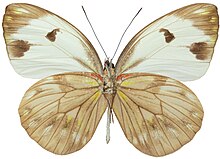| Pieriballia | |
|---|---|

| |
| Pieriballia viardi viardi from Oxchuc, Chiapas, Mexico | |
| Scientific classification | |
| Kingdom: | Animalia |
| Phylum: | Arthropoda |
| Class: | Insecta |
| Order: | Lepidoptera |
| Family: | Pieridae |
| Genus: | Pieriballia Klots, 1933 |
| Species: | P. viardi |
| Binomial name | |
| Pieriballia viardi (Boisduval, 1836) | |
| Synonyms | |
|
Genus:
Species:
| |
Pieriballia is a genus of butterflies in the family Pieridae erected by Alexander Barrett Klots in 1933. Its only species, Pieriballia viardi, the painted white or viardi white, was first described by Jean Baptiste Boisduval in 1836. It is found from Mexico to Bolivia and Paraguay. Strays can be found in southern Texas in the United States. The habitat consists of rainforests and transitional cloud forests.
The wingspan is about 57 mm (2.2 in).
The larvae feed on Capparis pseudocacao.
Subspecies
The following subspecies are recognised:
- P. v. viardi (Mexico, Honduras)
- P. v. locusta (C. Felder & R. Felder, 1861) (Colombia)
- P. v. mandela (C. Felder & R. Felder, 1861) (Venezuela)
- P. v. noctipennis (Butler & H. Druce, 1872) (Costa Rica, Panama)
- P. v. apicalis (Butler, 1898) (Ecuador)
- P. v. tithoreides (Butler, 1898) (Ecuador)
- P. v. rubecula (Fruhstorfer, 1907) (Peru, Bolivia)
- P. v. molione (Fruhstorfer, 1908) (Paraguay, Argentina)
- P. v. decorata (Joicey & Talbot, 1928) (Peru)
- P. v. interposita (Joicey & Talbot, 1928) (Peru)
References
- ^ Savela, Markku (November 9, 2014). "Pieriballia viardi (Boisduval, 1836)". Lepidoptera and Some Other Life Forms. Retrieved January 10, 2020.
- ^ "Viardi White". Butterflies of the Amazon and Andes. Learn About Butterflies. Retrieved January 10, 2020.
- Quinn, Mike (December 31, 2017). "Species Pieriballia viardi - Painted White - Hodges#4189.3". BugGuide. Retrieved January 10, 2020.
| Taxon identifiers | |
|---|---|
| Pieriballia viardi | |
This Pieridae-related article is a stub. You can help Misplaced Pages by expanding it. |
- Pierini
- Monotypic butterfly genera
- Pieridae of South America
- Taxa named by Alexander Barrett Klots
- Pieridae genera
- Taxa described in 1933
- Butterflies of Central America
- Lepidoptera of Mexico
- Lepidoptera of Venezuela
- Lepidoptera of Colombia
- Lepidoptera of Ecuador
- Lepidoptera of Peru
- Lepidoptera of Bolivia
- Lepidoptera of Argentina
- Fauna of Costa Rica
- Fauna of Panama
- Pieridae stubs